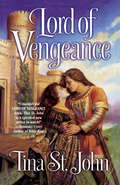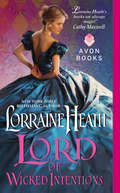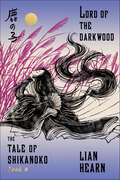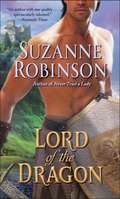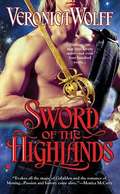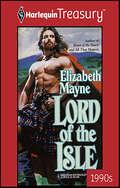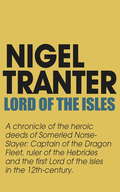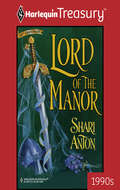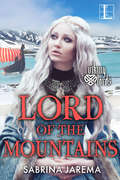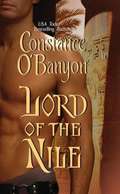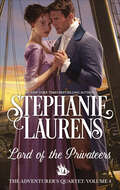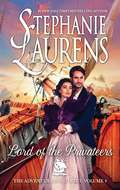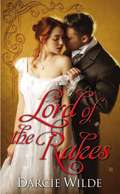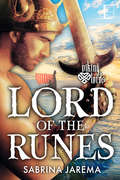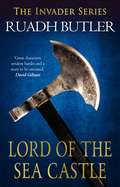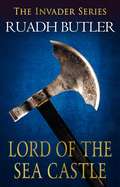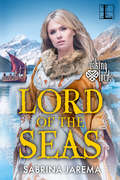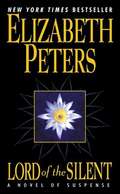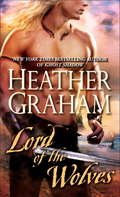- Table View
- List View
Lord of Vengeance
by Tina St. JohnDear Reader,Every so often you pick up a book that captures your heart, reminding you of all the reasons you first started reading romances . . . the breathtaking setting, the rich passions of a noble hero, the rapturous story of a love that cannot be denied. All these wonderful elements can be found in LORD OF VENGEANCE by Tina St. John.Set in majestic medieval England, LORD OF VENGEANCE is the compelling tale of two valiant people who struggle with the sins of the past to forge a love as turbulent as the land they live in. Devilishly handsome Gunnar Rutledge has spent years plotting against the man who nearly destroyed his life. He seeks the ultimate vengeance on Raina d'Bussy--his enemy's daughter--a proud beauty who will be slave to no man. Gunnar sets out to break Raina's glorious spirit but instead finds himself bewitched by her goodness, her strength.I was swept away by this first novel, and I believe that Tina St. John shows exquisite talent--she is a shining new romance star. And LORD OF VENGEANCE is just the beginning. . . .Enjoy!Shauna SummersSenior EditorThe Ballantine Publishing GroupFrom the Paperback edition.
Lord of War: Ein Mittelalter-Liebesroman
by Kathryn Le VequeIm Kampf ist er allen überlegen A.D. 1356 – Es sind kriegerische Zeiten in England, als der Schwarze Prinz sich seinen Weg durch Frankreich bahnt und dabei einen schmutzigen Krieg gegen die Bevölkerung führt. Der führende Kopf dieser brutalen Strategie ist jener Ritter, den sie den Schwarzen Engel nennen. Brandt de Russe, der gleichermaßen schlaue wie furchterregende Herzog von Exeter ist verantwortlich für die Kriegsmaschinerie des Prinzen und ein Koloss von einem Mann. Im Kampf ist ihm kein Mann gewachsen. Lady Ellowyn de Nerra, Enkelin des Söldners Braxton de Nerra, wurde von ihrem verkrüppelten Vater nach London entsandt, um für ihn die Männer abzuholen, die er dem Schwarzen Prinzen für seine Kriege in Frankreich zur Verfügung gestellt hatte. Die Männer De Nerras befinden sich unter jenen des Herzogs von Exeter, daher geht Ellowyn zum Hafen, als der Herzog seine Armee ausschifft. Bei ihrem Versuch, sich Brandt vorzustellen und ihren Auftrag zu erläutern, erübrigt der Herzog nur wenig Zeit für die schöne junge Frau und verwechselt sie noch dazu mit einer Hure. Zutiefst beleidigt findet Ellowyn daraufhin nur drohende Worte für diesem Mann, den alle vernünftigen Männer fürchten. Und so beginnt die feurige, leidenschaftliche und innige Liebesgeschichte, die Familien, Könige und zwei Kontinente umspannt und ihren Höhepunkt in der Schlacht von Poitiers findet, bei der Brandt in der ersten Reihe kämpft. Im Kampf ist ihm zwar kein Mann gewachsen, doch selbst die mächtigsten Männer sind Gefangene ihrer Herzen. Genre: FIKTION / Liebesroman / Allgemein
Lord of Wicked Intentions
by Lorraine HeathThree young heirs, imprisoned by anunscrupulous uncle, escaped--to the sea, to the streets, to faraway battle--awaiting the day when they wouldreturn to reclaim their birthright . . . Lord Rafe Easton may be of noble blood, but survival taughthim to rely only on himself and to love no one. Yet when he setseyes on Miss Evelyn Chambers, an earls illegitimate daughter, he is determined to have her, if only as his mistress . . . After her fathers death, Evelyn Chambers never imaginedshe would be sold to the highest bidder, yet circumstancesgive her little choice but to accept the lords indecent proposal. Rafe is wealthy, as well as ruthless. Yet his coldnessbelies deep passion and deeper secrets. If she must be his, Evelyn intends to lay bare everything the Lord of Pembrookis hiding. But dark discoveries threaten to destroythem both until unexpected love leadsthe last lost lord home . . .
Lord of the Darkwood: Book 3 In The Tale Of Shikanoko (The Tale of Shikanoko #3)
by Lian HearnA self-assured warrior stumbles into a game of Go that turns fatal. An ambitious lord leaves his nephew for dead and seizes his lands. A stubborn father forces his son to give up his wife to his older brother. A powerful priest meddles in the succession to the Lotus Throne. A woman of the Old People seeks five fathers for her five children, who will go on to found the Spider Tribe and direct the fate of the country.As destiny weaves its tapestry in Lian Hearn's Tale of Shikanoko series, an emotionally rich and compelling drama plays out against a background of wild forests, elegant castles, hidden temples, and savage battlefields in Lord of the Darkwood."Brutally thrilling historical fantasy"- Herald SunThe Tale of ShikanokoBook One: Emperor of the Eight IslandsBook Two: Autumn Princess, Dragon ChildBook Three: Lord of the DarkwoodBook Four: The Tengu's Game of Go
Lord of the Dragon: A Novel
by Suzanne RobinsonHeartstoppingly romantic, dangerously erotic, and filled with the vivid period details that bring an era to life, Suzanne Robinson's captivating novels have made her one of the reigning stars of historical romance. In this enticing love story, a willful beauty and a vengeful knight cross swords. The day he was banished from England, his fellow knights thought they'd seen the last of Gray de Valence. But the ruthless, emerald-eyed warrior had done more than survive in a world of barbaric dangers, he'd triumphed. Now, eager to pay back his betrayers, de Valence has come home only to find his plans threatened, not by another man but by a volatile, unpredictable, ravishingly beautiful woman. Vowing her own brand of vengeance against the high-handed, impossibly handsome knight, Juliana Welles will do her best to thwart him, to tempt and taunt him . . . until all Gray sees--and all he wants--is her. Yet when a ruthless enemy puts their lives in peril, the fearless knight will have to choose between his perfect revenge and the passion of a lifetime.From the Paperback edition.
Lord of the Far Island
by Victoria HoltLovely Ellen Kellaway knew very little about her past. Orphaned as a child and taken in by her arrogant mean-minded cousin as a "poor relation," she was grateful when the handsome young son of a wealthy family asked for her hand. But mysteriously, the marriage never took place. Ellen was unexpectedly rescued from a bleak future by a summons from her newly discovered guardian, Jago Kellaway, Lord of the Far Island, off the wild coast of Cornwall. There, on the special island of the Kellaways, Ellen was driven deeper and deeper into the secrets of a past as alive and threatening as the present. There the enigmatic Jago Kellaway offered her the fabled Island Necklace worn by the mistresses of Kellaway Castle. Was it a promise of happiness--or a dark symbol of death?
Lord of the Highlands
by Veronica WolffAn online dating service may have pronounced Felicity "unmatchable" but she's determined-and destined-to find her perfect mate. All it takes is a mystical deck of Tarot cards and suddenly she's in 17th-century Scotland, smitten by a warrior who must make a daring choice: send Felicity back to her own time, or endanger both their lives.
Lord of the Isle
by Elizabeth MayneHe Was The O'Neill,or so claimed those expecting him to drive the English from Ireland's shores. But Hugh O'Neill was uncertain what destiny demanded of him-until he rode to the aid of Morgana Fitzgerald, a woman with a price on her head and a passion blazing in her eyes!Witch And Traitor,they branded her, but Morgana Fitzgerald was bound by family honor to live a life on the run, until the moment she called on the spirits to help her-and Hugh O'Neill warrior of Ulster, appeared in her hour of need!
Lord of the Isles
by Nigel TranterBy the power of his sword arm, his dragon fleet and his sheerpersonality, Somerled Norse Slayer carved an enduring name for himselfin Scottish legend.Inheriting his father's shattered thanedom in Argyll in the twelfthcentury, he enlarged it by courage, initiative, military shrewdness anddiplomacy. For decades his navy held the balance of power in thenorthern seas, and it was he who cleared the Vikings out of theHebrides.Set against the romantically celebrated West Highlands and Western Islesof Scotland, the story of the conquests and courage of this hero king isa living tribute to a renowned legend.A thrilling story of the Scottish Isles in the 12th century by NigelTranter, master of Scottish historical fiction.By the power of his sword arm, his dragon fleet and his sheerpersonality, Somerled Norse Slayer carved an enduring name for himselfin Scottish legend.Inheriting his father's shattered thanedom in Argyll in the twelfthcentury, he enlarged it by courage, initiative, military shrewdness anddiplomacy. For decades his navy held the balance of power in thenorthern seas, and it was he who cleared the Vikings out of theHebrides.Set against the romantically celebrated West Highlands and Western Islesof Scotland, the story of the conquests and courage of this hero king isa living tribute to a renowned legend.A thrilling story of the Scottish Isles in the 12th century by NigelTranter, master of Scottish historical fiction.
Lord of the Isles
by Nigel TranterBy the power of his sword arm, his dragon fleet and his sheerpersonality, Somerled Norse Slayer carved an enduring name for himselfin Scottish legend.Inheriting his father's shattered thanedom in Argyll in the twelfthcentury, he enlarged it by courage, initiative, military shrewdness anddiplomacy. For decades his navy held the balance of power in thenorthern seas, and it was he who cleared the Vikings out of theHebrides.Set against the romantically celebrated West Highlands and Western Islesof Scotland, the story of the conquests and courage of this hero king isa living tribute to a renowned legend.A thrilling story of the Scottish Isles in the 12th century by NigelTranter, master of Scottish historical fiction.By the power of his sword arm, his dragon fleet and his sheerpersonality, Somerled Norse Slayer carved an enduring name for himselfin Scottish legend.Inheriting his father's shattered thanedom in Argyll in the twelfthcentury, he enlarged it by courage, initiative, military shrewdness anddiplomacy. For decades his navy held the balance of power in thenorthern seas, and it was he who cleared the Vikings out of theHebrides.Set against the romantically celebrated West Highlands and Western Islesof Scotland, the story of the conquests and courage of this hero king isa living tribute to a renowned legend.A thrilling story of the Scottish Isles in the 12th century by NigelTranter, master of Scottish historical fiction.
Lord of the Isles (Highland #6)
by Amanda ScottThe sexy Scottish lords, the Maclean twins, return in this follow-up to "Highland Princess." Forced into a scheme by her father, Cristina Macleod tricks Hector Maclean into marrying her. But Hector comes to realize that Cristina is, indeed, his true love. Original.
Lord of the Manor
by Shari Anton10TH ANNIVERSARYHis enemy's wifeNo matter that the Lady Lucinda had borne a son to the man who had almost killed him, Richard of Wilmont wanted her anyway. For the fair widow brought to him a sense of belonging...and a love so powerful it would erase the past.What could she ever be to him? Lucinda wondered. Surely a knight as chivalrous as Richard of Wilmont had worthier women than she to claim his attention. She was an outcast, and unfit as wife for any man...!
Lord of the Mountains (The Viking Lords #2)
by Sabrina JaremaAmid the glittering fjords and majestic mountains of Norway, this stunning series delves into the loves, battles, and dreams of the Viking clans—powerful men and women who believed in the call of the flesh as well as the soul…It was said that the man who could look into Silvi Ivarsdottir’s eyes would be meant for her. Powerful jarl Magnus Sigrundson knows he is that man, and that Silvi’s dowry can give him the ships, swords, and silver he needs for his trading empire. Yet beautiful Silvi’s dream is not to be a wife, but a Priestess of the gods for the great temple at Uppsala. Who dares interfere with such passion? The answer lies in Silvi herself, in the way her body awakens to Magnus’ touch, in the way she inspires a reverence he didn’t know he possessed—and in the battles she takes on when she journeys to his mountain home of Thorsfjell.But soon a dangerous, deceitful enemy threatens to shatter their new life together. Now they face another quest: can they find each other again—and dare live and love in each other’s worlds?“Lord of the Mountains will mesmerize you from the first page . . . Jarema’s in-depth knowledge of Norwegian customs makes this story believable.” —RT Book Reviews, 4 stars
Lord of the Nile
by Constance O'BanyonThe daughter of an animal trainer gets involved with a nobleman-soldier, and with the plots surrounding Caesar, Cleopatra, and young King Ptolemy in ancient Alexandria. Some descriptions of sex. From the book jacket: AN UNCERTAIN CONQUEROR Ramtat saw her tears and was almost undone. "I have no right to touch you since you are under my protection." She took several quick steps away from him. "How can I trust you now? If you can't keep away from me, then let me go home!" Ramtat stalked across the rug to stand before her, capturing her face between his hands and turning it toward the lantern. "The gods have given you the face of a goddess, the green eyes of our queen, and a temper that would sour goat's milk." She stared at him coldly. "I'm glad you dislike me. I would consider it an insult if you thought well of me." Overcome with weariness, he sat on one of the couches. "I've never implied I disliked you." He looked at her, totally confused. He had commanded legions, conquered nations and been covered with glory, but nothing had prepared him for his encounters with Lady Danae. "I am no longer surprised that your father kept you hidden in the country. In the few weeks I've known you, you have made an enemy of Gaius Julius Caesar, the most powerful man in the world, and if you hadn't left Alexandria when you did, you might have toppled the whole Ptolemaic Dynasty."
Lord of the Plains
by Velda SherrodTo save her sister, saloon singer Kate Hartland played the hundred dollar whore. Trembling in her innocence, she seduced a handsome outsider who appeared safe, kind, and Irish. But the virile stranger turned out to be anything but safe. He awakened a dangerous passion, incited torturous longings, and worst of all possessed hated Comanche blood. As Sean O'Brien he took her virginity, claiming her in the most primitive sense. As Grayhawk he saved her life, making her his wife in the eyes of the Comanche. But the man known as Lord of the Plains, the man who walked in both the world of his Irish father and that of his Comanche mother, had yet to win Kate's love. And so as he risked death to unite the white settlers and the Indians in peace, he also risked his spirit to unite body and soul with the lass who had captured his heart.
Lord of the Privateers (The Adventurer's Quartet #4)
by Stephanie LaurensThe thrilling conclusion to the #1 New York Times–bestselling author’s sexy and swashbuckling Regency romance series.Known as the lord of the privateers, Royd Frobisher is determined to finish the high seas rescue mission his younger brothers began. But his daring plan doesn’t account for Isobel Carmichael—his emotional nemesis, childhood sweetheart, ex-handfasted bride, and current business partner—coming along.Isobel has a mission of her own—find her cousin Katherine and bring her safely home. Along the way, she hopes to rid herself of the lingering desire for Royd that still haunt her. As their adventure takes them from the high seas to sweltering jungles and the glittering ballrooms of Mayfair, they are drawn once again to the flame of undeniable passion. But having glimpsed the future that could be theirs, they must finally ask what they are willing to risk in the name of duty . . .
Lord of the Privateers (The Adventurers Quartet)
by Stephanie LaurensCan true love die? Or, neglected, does it lie dormant until the object of true desire is again within reach? Denied, does passion smolder, like embers waiting for the right conditions to flare into an all-consuming conflagration? <P><P> #1 New York Times bestselling author Stephanie Laurens delivers the thrilling conclusion to her acclaimed series, THE ADVENTURERS QUARTET, a passionate Regency-era drama played out on the high seas and in the sweltering heat of tropical jungles, ultimately reaching a scintillating climax in the glittering ballrooms of Mayfair.<P> The eldest of the Frobisher brothers and widely known as the lord of the privateers, Royd Frobisher expects to execute the final leg of the rescue mission his brothers have been pursuing. What he does not expect is to be pressured into taking his emotional nemesis, childhood sweetheart, ex-handfasted bride, and current business partner, Isobel Carmichael, with him. But is it Isobel doing the pressuring, or his own restless unfulfilled psyche?<P> Resolute, determined, and an all but unstoppable force of nature, Isobel has a mission of her own—find her cousin Katherine and bring her safely home. And if, along the way, she can rid herself of the lingering dreams of a life with Royd that still haunt her, well and good.<P> Neither expects the shock that awaits them as they set sail aboard Royd's ship, much less the new horizons that open before them as they call into London, then, armed with the necessary orders and all arrangements in place, embark on a full-scale rescue-assault on the mining compound buried in the jungle.<P> Yet even with the support of his brothers and their ladies and, once rescued, all the ex-captives, Royd and Isobel discover that freeing the captives is only half the battle. In order to identify and convict the backers behind the illicit enterprise—and protect the government from catastrophic destabilization—they must return to the ballrooms of the haut ton, and with the help of a small army of supporters, hunt the villains on their home ground.<P> But having found each other again, having glimpsed the heaven that could be theirs again, how much are they willing to risk in the name of duty?<P> Learn the answer and revel in the action, drama, intrigue, and passion as the Frobishers—with help from Wolverstone, the Cynsters, and many familiar others—steer the adventure to a glorious end. <P><b>A New York Times Bestseller</b>
Lord of the Rakes
by Darcie WildeAn undeniable rogue meets his match in a spirited heiress in this "strong and spicy"* regency romance debut from Darcie Wilde.It’s no wonder that Phillip Montcalm is better known as the "Lord of the Rakes." With an extensive list of conquests, Phillip has truly earned his reputation as the most dangerous seducer in London. Talk of his prowess as a lover and his ingenuity in the bedroom are enough to make even the most prudish of ladies succumb to temptation. But as of late, Phillip has found himself a bit bored. Until he sets his eyes on a fiery newcomer.New to independence and London, gorgeous heiress Lady Caroline Delamarre wants to make the most of her life. And when Phillip meets her gaze, she knows the perfect place to start is in his arms...and in his bed. But what begins as a long night of breathtaking passion leads to more than the two bargained for. Haunted by troubled pasts and inescapable family entanglements, each of them must decide if they can risk a gamble on what might be true love.From the Paperback edition.
Lord of the Runes (The Viking Lords #1)
by Sabrina JaremaIn this exciting new series, the dramatic world of the Vikings is brought to life in vivid, historical detail. As brave warriors fight to defend family honor and tradition, they discover unexpected passion with memorable women who only further their resolve for justice . . . Following his father’s murder, Eirik Ivarson plunges into a maelstrom of brutal warfare. As outsiders threaten his homeland and all he holds dear, Eirik vows to maintain his focus and avenge the jarl’s death. In his quest for revenge, he will leave everything behind, all he knows, and all he loves. Asa Sigrundsdottir, a spirited shieldmaiden with warm brown eyes, is wary of the golden-haired warrior discovered half-frozen in a storm. It is clear Eirik is a man of valor, bestowed with the gift of reading runes and destined for greatness. And despite the shadows in her past, he chooses her to help him on his journey. But when their bond is tested, it will take the strength of a hero to keep their love alive . . .“Lord of the Mountains will mesmerize you from the first page . . . Jarema’s in-depth knowledge of Norwegian customs makes this story believable.” —RT Book Reviews, 4 stars
Lord of the Sea Castle
by Edward Ruadh ButlerIt is 1170 – a tumultuous time for the people of Wales, England and Ireland. Raymond de Carew is in love, but the woman he desires is an earl's daughter and so far above his station that he has no hope of ever winning her. However, Raymond’s lord has a mission for him: one that if it succeeds will put an Irish king back on his throne and prove Raymond worthy – for in Norman society, a man can rise as high as his skill with a sword can take him. With only a hundred men at his side, Raymond must cross the ocean to Ireland ahead of his mercenary lord's invasion. There he will face the full might of the Viking city of Waterford... and either his deeds will become legend or he will be trampled into dust. The second volume in the thrilling Invader series by E.R. Butler.
Lord of the Sea Castle: The Invader Series (The Invader Series #2)
by Edward Ruadh ButlerIt is 1170 – a tumultuous time for the people of Wales, England and Ireland. Raymond de Carew is in love, but the woman he desires is an earl's daughter and so far above his station that he has no hope of ever winning her.However, Raymond’s lord has a mission for him: one that if it succeeds will put an Irish king back on his throne and prove Raymond worthy – for in Norman society, a man can rise as high as his skill with a sword can take him.With only a hundred men at his side, Raymond must cross the ocean to Ireland ahead of his mercenary lord's invasion. There he will face the full might of the Viking city of Waterford... and either his deeds will become legend or he will be trampled into dust.
Lord of the Seas (The Viking Lords #3)
by Sabrina JaremaThe Vikings roamed and raided the known world, always returning to their beautiful, sacred realm. Now, a young Christian woman is forced into this land—by a Viking lord with a secret he dares not reveal . . . From Istanbul to Ireland, Rorik of Vargfjell is legendary for the battles he has fought, the wealth he has amassed, and the women he has loved. So when a Northumbrian Earl refuses to pay tribute, and even burns one of Rorik’s ships, the Viking seizes the earl’s daughter—and will hold her for ransom. Or so was his plan. At home in Northumbria, Elfwynn had experienced agonizing losses—including the peaceful world she was born into. Now she stands face to face with a towering, chiseled Viking in his wondrous kingdom. With her gift of music, her unworldly beauty and strange courage, Elfwynn will prove to be very different than any woman Rorik has known. And for a man who lords over sea and land, what she demands will be the greatest challenge of all . . .“Lord of the Mountains will mesmerize you from the first page . . . Jarema’s in-depth knowledge of Norwegian customs makes this story believable.” —RT Book Reviews, 4 stars
Lord of the Silent
by Elizabeth PetersThe ghosts of an ancient past and the specters of a present-day evil are buried beneath the Egyptian sands . . . For archaeologist Amelia Peabody and her family, the allure of Egypt remains as powerful as ever, even in 1915, as a World War rages. But nowhere in this exotic land is safe--especially for Amelia's son Ramses and his beautiful new wife Nefret. Treachery and danger pursue the two young lovers across the desert nation, strengthening a bond of passion and devotion that only death can sever. And the grim discovery of a recent corpse in a tomb where it does not belong is pulling Amelia deeper into a storm of intrigue, corruption, kidnapping, and murder--and toward dark revelations that threaten to awaken the past . . . and alter the family's destiny.
Lord of the Sky
by Linda Zeman-SpalenyA breathtakingly illustrated tribute to the art and mythology of West Coast native culture.In this exquisitely illustrated picture book, based on the animated short film of the same name, Linda Zeman-Spaleny transports young readers to a bygone time when nothing lived in the universe, when “out of the darkness came the Great Raven, who brought the Sun to the children of the North Pacific Coast.” Legend tells of a boy, living by the sea, who befriends the ravens, sharing his food with them. But some of the ravens are greedy, and the village boys decide to teach them a lesson by sending a swift and fatal arrow. When darkness descends upon the land, the wise elder tells the villagers that only the Lord of the Sky can restore the Sun, so the boy begins an arduous journey in search of him. . . .In this riveting folktale, Linda Zeman-Spaleny pays tribute to her emigration from Eastern Europe and her arrival in British Columbia, where she saw beautiful totem poles for the first time. Award-winning artist Ludmila Zeman’s lush, vibrant artwork complements this timeless tale with modern themes and the message that we need to care for our world in order to preserve it.
Lord of the Wolves (MacAuliffe Vikings Trilogy #3)
by Heather GrahamShe was the heroine of her people....With her extraordinary violet eyes, French Countess Melisande was a prize for any man. But the teenage hellion who rode into battle to defend her people belonged to the warrior who saved her life, made her his bride, then disappeared for years. Now Conar MacAuliffe had returned to claim his wife, now a ravishing woman determined to fight for her freedom at all costs. But the proud beauty who feared no man suddenly feared herself and the passionate embrace of the husband who vowed to never let her go.He was the mighty viking conqueror they called...Lord of the Wolves, a legendary warrior whose greatest challenge would come with the woman he was destined to wed. In the fiery Countess Melisande he would find his heaven and hell. Even as he waged war for her heart, he dared not to yield his own. Even as he laid sweet, seductive siege to her body, he tried to shield his soul. It would take a common enemy, a little trust, and a united front to awaken them both to a love that could change their lives forever.From the Paperback edition.
